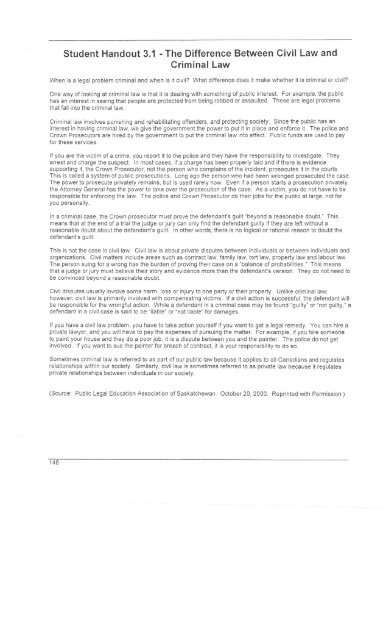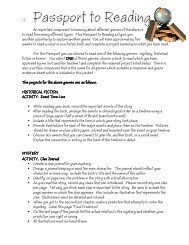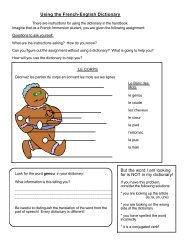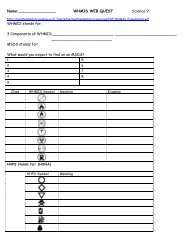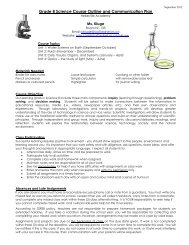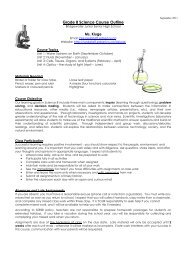Student Handout 3.1 - The Difference Between Civil Law and ...
Student Handout 3.1 - The Difference Between Civil Law and ...
Student Handout 3.1 - The Difference Between Civil Law and ...
Create successful ePaper yourself
Turn your PDF publications into a flip-book with our unique Google optimized e-Paper software.
<strong>Student</strong> <strong>H<strong>and</strong>out</strong> <strong>3.1</strong> - <strong>The</strong> <strong>Difference</strong> <strong>Between</strong> <strong>Civil</strong> <strong>Law</strong> <strong>and</strong><br />
Criminal <strong>Law</strong><br />
When is a legal problem criminal <strong>and</strong> when is it civil? What difference does it make whether it is criminal or civil?<br />
One way of looking at criminal law is that it is dealing with something of public interest. For example, the public<br />
has an interest in seeing that people are protected from being robbed or assaulted. <strong>The</strong>se are legal problems<br />
that fall into the criminal law.<br />
Criminal law involves punishing <strong>and</strong> rehabilitating offenders, <strong>and</strong> protecting society. Since the public has an<br />
interest in having criminal law, we give the government the power to put it in place <strong>and</strong> enforce it. <strong>The</strong> police <strong>and</strong><br />
Crown Prosecutors are hired by the government to put the criminal law into effect. Public funds are used to pay<br />
for these services.<br />
lf you are the victim of a crime, you report it to the police <strong>and</strong> they have the responsibility to investigate. <strong>The</strong>y<br />
arrest<strong>and</strong>chargethesuspect. Inmostcases,ifachargehasbeenproperlylaid<strong>and</strong>ifthereisevidence<br />
supporting it, the Crown Prosecutor, not the person who complains of the incident, prosecutes it in the courts.<br />
This is called a system of public prosecutions. Long ago the person who had been wronged prosecuted the case.<br />
<strong>The</strong> power to prosecute privately remains, but is used rarely now. Even lf a person starts a prosecution privately,<br />
the Attorney General has the power to take over the prosecution of the case. As a victim, you do not have to be<br />
responsibleforenforcingthelaw. <strong>The</strong>police<strong>and</strong>CrownProsecutordotheirjobsforthepublicatlarge,notfor<br />
you personally.<br />
In a criminal case, the Crown prosecutor must prove the defendant's guilt "beyond a reasonable doubt." This<br />
means that at the end of a trial the judge or jury can only find the defendant guilty if they are left without a<br />
reasonable doubt about the defendant's quilt. In other words. there is no loqical or rational reason to doubt the<br />
defendant's guilt.<br />
This is not the case in civil law. <strong>Civil</strong> law is about private disputes between individuals or between individuals <strong>and</strong><br />
organizations, <strong>Civil</strong> matters include areas such as contract law, family law, tort law, property law <strong>and</strong> labour law.<br />
<strong>The</strong> person suing for a wrong has the burden of proving their case on a "balance of probabilities." This means<br />
that a judge or jury must believe their story <strong>and</strong> evidence more than the defendant's version. <strong>The</strong>y do not need to<br />
be convinced beyond a reasonable doubt.<br />
<strong>Civil</strong> disputes usually involve some harm, loss or injury to one party or their property. Unlike criminal law,<br />
however, civil law is primarily involved with compensating victims. lf a civil action is successful, the defendant will<br />
be responsible for the wrongful action. While a defendant in a criminal case may be found "guilty" or "not guilty," a<br />
defendant in a civil case is said to be "liable" or "not liable" for damages.<br />
lf you have a civil law problem, you have to take action yourself if you want to get a legal remedy. You can hire a<br />
private lawyer, <strong>and</strong> you will have to pay the expenses of pursuing the matter. For example, if you hire someone<br />
to paint your house <strong>and</strong> they do a poor job, it is a dispute between you <strong>and</strong> the painter. <strong>The</strong> police do not get<br />
involved. lf you want to sue the painter for breach of contract, it is your responsibility to do so.<br />
Sometimes criminal law is referred to as part of our public law because it applies to all Canadians <strong>and</strong> regulates<br />
relationships within our society. Similarly, civil law is sometimes referred to as private law because it regulates<br />
private relationships between individuals in our society.<br />
(Source: Public Legal Education Association of Saskatchewan. October 20,2000. Reprinted with Permission.)<br />
146
<strong>Student</strong> <strong>H<strong>and</strong>out</strong> 3.6 - Poirier v. Murphy Gase Study<br />
<strong>The</strong> Facts<br />
Peter Poirier <strong>and</strong> John Murphy, both 18 years of age, agreed to carry out a "stunt." <strong>The</strong> stunt was performed in<br />
an underground parking garage. Peter stood underneath a water sprinkler pipe. After Peter nodded, John began<br />
driving his car from about 100 feet away <strong>and</strong>, at the last moment, Peter would jump up, grab the pipe, do a chinup,<br />
swerve his hips <strong>and</strong> legs to one side <strong>and</strong> clear the car. Drinking was not involved. <strong>The</strong> stunt was performed<br />
as a form of amusement for Peter <strong>and</strong> John, <strong>and</strong> a group of their friends who were in the car with them.<br />
<strong>The</strong> stunt was performed safely a first time, but the second time Peter was not prepared for it. Peter was hit by<br />
the car <strong>and</strong> injured. He became unconscious, suffered a brain injury, <strong>and</strong> underwent lasting personality <strong>and</strong><br />
emotional changes.<br />
Questions to Consider<br />
1. Did Peter knowingly assume the risk of harm when he agreed to carry out the stunt?<br />
2. Was John negligent? Did he fail to take proper care to avoid harm to Peter?<br />
3. Did Peter contribute to his own injuries by not taking reasonable care of himself?<br />
4. How would you decide the case <strong>and</strong> why?<br />
<strong>The</strong> Judge's Decision<br />
<strong>The</strong> judge held that Peter had given up his right to sue for negligence the first time the stunt was performed,<br />
because he willingly assumed the risk of harm. <strong>The</strong> second performance of the stunt was different because Peter<br />
was not ready to perform the stunt. Peter did not assume a risk until he nodded his approval, <strong>and</strong> he did not do<br />
so for the second run.<br />
Both Peter <strong>and</strong> John were negligent. John was negligent because he owed a duty as the driver of the car to take<br />
care. He should have realized that Peter was not ready for the second stunt. John was 2/3 at fault.<br />
Peter was also partly responsible for his own injuries. He was negligent in agreeing to do the stunt <strong>and</strong> in not<br />
removing himself from the risk of harm before the second stunt. Peter was 'l13 at fault.<br />
(Source: Public Legal Education Association of Saskatchewan. Reprinted with permission.)<br />
160


